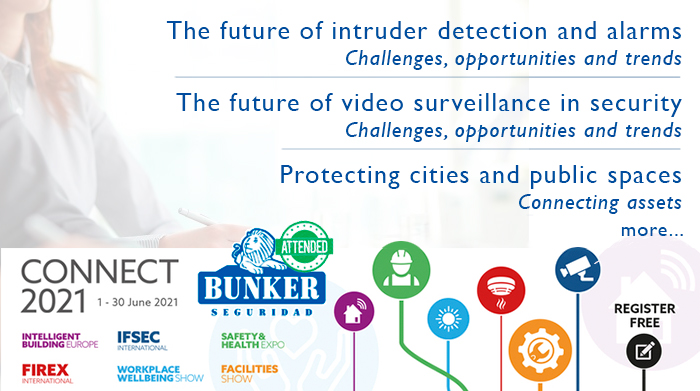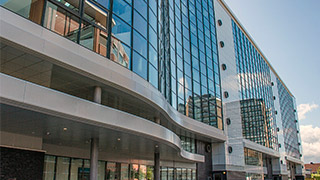During last month we had been attending the virtual IFSEC International Connect 2021 that took place alongside FIREX International (fire safety), Safety & Health Expo, Intelligent Buildings, Workplace Wellbeing Show and Facilities Show (facilities management). We especially enjoyed the conference sessions about Intrusion Detection, Video Surveillance and Perimeter Protection as well as the discussions on the questions sent by professionals.
The future of intruder detection and alarms – Challenges, opportunities and trends
This session had experienced professionals from different companies as speakers. They spoke about the transformation of the intruder alarm system from the traditional plain signaling device to a much more interractive systems that give more detailed and accurate information to the end user and the installer, but also better remote control options.
The discussion covered some current threats, the areas where growth is expected such as small shops, restaurants, residential areas, office spaces and all the healthcare and other facilities that have very obsolete security systems. When it comes to IP and cloud-based products and systems, they are more and more accepted now, but it is important to realise that as soon as you are connected, you are exposed and should run checks and diagnostics on a daily basis.
What about integrated systems for intruder detection and alarms, while a simple PIR detector can provide important data, if you have another layer such as video analytics systems, you gain a more complete picture. So you can add more sensors and analytics to provide a much better decision making proccess, including data from IoT (Internet of Things) devices.
Commenting on the residential sector, vendors say they notice a growing demand for ‘smart home’ products and at the same time that remote access from homeowners is also becoming a requirement.
Standards have to be adapted and brought closer to the customer’s needs, following the trends of the market, even being proactive to keep ut with the upcoming demands.
On the other hand, traditional security supplier and installer market has an opportunity to promote professionalism and build reputational trust with consumers.
The different perspectives of the participants allowed us to assemble a complete picture of what can be achieved and to better understand where trends and common challenges in the security sector converge.
Supporting Analytics with Standards
ONVIF provided an overview on the types of metadata and how they can be communicated to the analytics systems. For example, event handling interfaces should be used for licence plate recognition, access control to parking lots and even for IoT systems (triggering a thermostat, alert, etc.).
Analytic metadata can be used for sending data between IP devices such as cameras and Video Management Software, Network video recorder, Server-based service or Cloud-based service. There are different type of metadata, it could be geolocation, licence plate number, etc. and it can be visually displayed to help security professionals or even for forensic search.
Compatibility not only makes integrations possible and much simpler, but also facilitates the creation of more complex systems.
Because there are a wider variety of devices producing and consuming data, we have to do more and in order to do that it is important to have and to follow specific directives for security. Standards will help to have increased interoperability of IP cameras or analytics with video management systems as well as simplify the integration with IoT systems.
The future of video surveillance in security – Challenges, opportunities and trends
The maturity of the technology reaches certain level as well as the capabilities of the devices, that gives a possibility AI can grow and now it is boosting analytics. COVID-19 pandemic has demostrated the imprtance of AI and Deep Learning. New technologies inlcuding facial recognition are becoming standardised, even how to install it and they are now very useful for the police, for example.
For installers, it depends of the size of the company, but if it is a big company they have to answer all the questions about the new applications and technoligies they had heard about. Education is key to this. The challenge for integrators and installers is to keep up with new developments.
For video surveillance, If we apply ethics with the end-user in mind, we can develop trusted technologies and there are a lot of guiadance available about privacy. Technology is not harmful, it usege can be, if we are not careful, but we often use it to do good and it contributes to the greater good avery day. The way how we deal with the information of any analytics is extremely important.
Manufactures hace to keep involved in the proccess to be able to perform checks of all the proccesses that are run automatically. Humans are still the ones making the decision, even for AI.
As more attack happen, because we are more moving to digital systems, everybody in the supply chain have to make sure their part in keeping the system secure is done. The equipment has to be design, installed and configurated as secure. Manufactures have to be aware if there are security breaches. If you are able to introduce a weakness to one point it would create a weakness for the whole chain. The responsabilityshouldn’t be left to the installers and integrators.
The integration of different between security devices, several kind of technologies or applications makes important the use of open protocols. The flexibilty of the network depends on that and there are fantastic opportunities are becoming available.
Protecting cities and public spaces – Connecting the assets
It is amazing how the world is changing, developing the concept of smart buildings, security integrations in the cities and how everything is expanding into more digitised environments.
Smart cities are facing challenging threats. Some of the most common vulnerabilities for them take place in code libraries, vendor application code, technolgogy standards and protocols, configuration and installation. The manegament of devices, connections and systems could also add vulnerabilities. When management staff is tricking the system it also makes them more vulnerable. The volume of data and the number of data collection practices of vendors and facilities make it more difficult to keep the security under control.
There is a need of effective overall governance of the Smart Cities which isn’t separate from infrastructure management. Some times the management of the security is only focused on citizen benefits without taking into account the skills required to manage the complete project. It is important to provide complete situational awareness to manage threats and to help vendors to promote security products.
New emerging technologies such as 5G, edge, AI, blogchain, drones add additional threats needs to be known better and standardised.
The integration has to include everyone at every level, starting with developers writing code. While new vulnerabilities emerge, integration also provides us with tools to better monitor and control processes.
If we are looking to smart cities to improve the life of the citizens, part of that life is their ciberlife. If parking management, booking a restaurant, weather information, etc. are connected, the ciber attacks are going to affect the happiness of the citizens, so we need to broaden the approach to happiness and to think about the complete health and happiness.
New technologies and physical security procedures has to converge to combat emerging threats.


